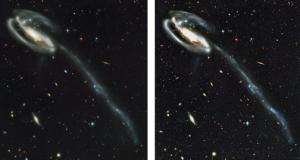Star Belts: Orion

_______________________________________________________
Alnitak, Alnilam, Mintaka
Credit: Digitized Sky Survey, ESA/ESO/NASA FITS Liberator
Color Composite: Davide De Martin (Skyfactory)
Alnitak, Alnilam, and Mintaka, are the bright bluish stars from east to west (left to right) along the diagonal in this cosmic vista.
Otherwise known as the Belt of Orion, these three blue supergiant stars are hotter and much more massive than the Sun. They lie about 1,500 light-years away, born of Orion's well-studied interstellar clouds. In fact, clouds of gas and dust adrift in this region have intriguing and some surprisingly familiar shapes, including the dark Horsehead Nebula and Flame Nebula near Alnitak at the lower left.
The famous Orion Nebula itself lies off the bottom of this star field that covers an impressive 4.4x3.5 degrees on the sky. The color picture was composited from digitized black and white photographic plates recorded through red and blue astronomical filters, with a computer synthesized green channel. The plates were taken using the Samuel Oschin Telescope, a wide-field survey instrument at Palomar Observatory, between 1987 and 1991.
Astronomy Picture of the Day 29 December 2006
Discover the cosmos! Each day a different image or photograph of our fascinating universe is featured, along with a brief explanation written by a professional astronomer.
_______________________________________________________
Blue Giants -Wolf-Rayet Stars by Plato
The Christmas Tree Cluster from Universe Today
Across the electromagnetic spectrum podacast by Universe Today
The Dark Side of Nature release from ESO European Space Observatories
_______________________________________________________
_______________________________________________________
Every culture has its own constellations and mythology. Constellations rarely look like the object their name suggests; many groupings of stars have been called different things over the years.
According to Greek mythology, the stars in this region of the sky are labeled Orion in honor of a great hunter, son of Neptune and the nymph Eurayle. This drawing from E. Burritt's atlas of 1835, shows the typical image of Orion -- club in hand, lion-skin shield, attacking the bull, Taurus.
To the Egyptians, the same stars were a tribute to the god of light, Osiris.
_______________________________________________________
_______________________________________________________
Famous Quotes: A will finds a way. Orison Swett Marden
There is no other investment you can make will pay you so well as the
effort to scatter sunshine and good cheer through your establishment
_______________________________________________________
_______________________________________________________
Labels: APoD, Orion, Star Belts






























Redchrono Electronic Xmas Lights
Some say I'm a particle, some say I'm a wave
oscillating at Xmas parties or New Year's rave
I even cheer-up Santa's Grotto, Santa's cave
A thousand airport runways at night I pave
every safe landing, pilots from error I save
People try to tell me where & how to behave
or which way they want me to pass & wave
if you are lucky I'll pretend to be your slave
but nothing can hold me down not the grave
The star on top, the xmas fairy she's a babe
but on Xmas trees, I'm all the children's fave
You can turn me on, you can turn me off
but never ever call me David Hasselhoff
A flick of the switch, and I'll start to glow
if you really want I'll put on quite a show
but mostly I just like to go with the flow
Thru the day & thru the night I like to play
I like to flicker on your dashboard display
Many lights you can see as you race thru town
Many lights when you cruise and travel around
In your car & dashboard display I'm the king
on the electronic dashboard I'm the real thing
I can be seen from near, can be seen from afar
but you know there is really nothing on a par
with how red the light glows inside your car
From the pages of Charmed, a White Lighter
I'm on the dashboard of kit from Night Rider
And if you listen to Pink, or Shirley Bassey
the uk extravaganza the M&S xmas ad for tv
You'll know "I can go for miles and miles..."
From the film Tron you are sure to have known
I can move faster than a supercharged electron
almost as if something from another dimension
passing thru gates & switches, I go on and on
Every person knows me, and drivers look for me
They want to know how fast they are travelling
They want to know how fast in the car to go
I silently keep them informed of the throbbing
the revs under the bonnet or long french capot
At great speeds, lying low on the faster roads
I'm even in the cockpits of passenger jumbo jets
flying at 30,000 feet or more, higher up above
flowing swiftly, flowing fast, graceful as I rove
Racing at 200KMH on the German autobahn
turn up the radio as it starts Golden Earring's
"Radar love" with words about forgotten song
music for those who been driving all night long
In France we finally arrive, nearing the tunnel
in Paris where Princess Diana did hit the rail
like someone straight out of a tragic fairy tale
On the stereo listen - to Billy Idol sing & roar
In the midnight hour, I want more, more, more
Enter the tunnel of light, steady as she goes
So you may have thought I had to be hard wired
for anything to get me excited, to get me fired
but as you can see here I never never get tired
when I'm in full flow and by you feeling inspired